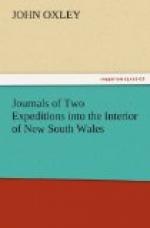September 29.—The country we passed through is what is generally known in New South Wales as open forest land, with occasionally small flats on the river: steep hills sometimes ended on the river, and north and south of us were detached ranges of a similar description. The whole face of the country was abundantly covered with good grass, which, having been burnt some time, now bore the appearance of young wheat. Six miles down the river it was joined by a fine stream from the southward, apparently watering a spacious valley. We crossed this, and named it Ellenborough River, in honour of the Chief Justice of England. We proceeded about three miles farther before we halted at the edge of a thick detached brush [Note: Many very beautiful shrubs inhabit these shaded thickets, of which the following may serve as a specimen. Tetranthera dealbata, BROWN’S PRODR.; Cryptocarya glaucescens, BR., genera of laurinae. The Australian sapota fruit, Achras australis, BR.; Cargillia australis, a date plum. Myrtus trinervia of Smith, and Ripogonum album, BR.], which came nearly down to the water’s edge. In this brush was a quantity of fine red cedar trees, affording us reason to hope, that this valuable wood might, as we advanced to the coast, be found in yet greater abundance. The timber generally might be termed heavy, consisting of blue gum, stringy bark, and iron bark, with fine forest oaks. The stones on the surface of the land were hard and splintery, being principally of coarse quartz; some hard sandstone was also seen: the rocks in the river were of a fine dark blue colour, singularly hard and slippery. Although we had seen no natives, there were abundant signs of them. This season probably is better calculated for them to procure their food on the coast than in the woods.
September 30.—Our progress this day was greatly impeded by thick brushes, which, covering the sides of the hills, ended on the river: some of them were upwards of a mile in extent, and we were obliged to cut a road to enable the horses to pass through them. There were several rich flats on both sides of the river; the hilly projections ending alternately at the several bends of the stream. The obstruction offered by the brushes excepted, the road was no wise difficult: the hills were stony, with rocky summits: the river’s course was over large rocks and pebbles; it was fordable in several places, with intervening deep reaches. It was late in the afternoon before we had accomplished six miles, and halting on a flat bounded easterly by extensive brush, I resolved to cross the river. There appears to be plenty of fish in it; we caught six fine perch, weighing above two pounds each, in a very short time. The timber continues heavy and good: we saw however but little cedar after passing the first brush.




